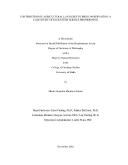| dc.contributor.advisor | DeClerck, Fabrice | |
| dc.contributor.author | Martinez Salinas, María A. | |
| dc.date.accessioned | 2017-06-22T15:14:24Z | |
| dc.date.available | 2017-06-22T15:14:24Z | |
| dc.date.issued | 2016 | |
| dc.identifier.uri | https://repositorio.catie.ac.cr/handle/11554/8594 | |
| dc.description | Tesis (Ph. D) - CATIE. Escuela de Posgrado, Turrialba (Costa Rica), University of Idaho (Estados Unidos), 2016 | es_ES |
| dc.description.abstract | Understanding the contribution of agricultural land uses to biodiversity conservation is of utmost importance. With 38% of earth’s ice free land surface covered by crops and pastures, studying and understanding the potential conservation value of these lands is critical for the future of conservation strategies, particularly in biodiversity conservation hotspots such as Central America. My research focused on understanding the contribution of different agricultural land uses and a forest fragment to bird conservation in a Costa Rican landscape. The study region is located at the heart of the Volcanica Central Talamanca Biological Corridor (VCTBC), a
national conservation strategy aiming at reconnecting the Volcanica Central and the
Talamanca Mountain Ranges. Chapter 1 and Chapter 2 are based on seven years of bird capture data produced by long-term mist-netting stations operating in eight different land uses, seven agricultural and a forest fragment. Chapter 1 comprises lessons learned during seven years of mist-netting efforts in eight land uses following a management intensity gradient. Chapter 2 focuses on bird community stability, stability understood as no changes from year to year in mean species richness and abundance of either the total population, or of resident and migratory species over a seven year period. Chapter 3 is based on an
experimental study focusing on the effect of bird species in the suppression of the Coffee Berry Borer (Hypothenemus hampei), one of the most detrimental coffee pests worldwide. Results from our research highlights the importance of including agricultural land uses in biodiversity conservation planning. Agroforestry systems particularly showed potential for bird conservation in agricultural landscapes while fostering stable bird communities that are closer in composition to our reference forest fragment. Additionally, our results also showed
that our landscape is capable of supporting bird species providing important pest control
services. Finally, despite the value of agricultural land uses our results also highlight that our forest fragment fosters unique bird communities when compared to agricultural lands. Conservation planning at the landscape level should considered the uniqueness of these habitats and integrate efforts to conserve forests and managed agricultural lands for biodiversity conservation, particularly in these human-dominated landscapes. | es_ES |
| dc.description.sponsorship | CATIE (Centro Agronómico Tropical de Investigación y Enseñanza) | es_ES |
| dc.language.iso | en | es_ES |
| dc.publisher | Centro Agronómico Tropical de Investigación y Enseñanza (CATIE) | es_ES |
| dc.rights | info:eu-repo/semantics/openAccess | |
| dc.subject | HYPOTHENEMUS HAMPEIPAJAROS | |
| dc.subject | CONSERVACION DE LA DIVERSIDAD BIOLOGICA | |
| dc.subject | CAFETALES | |
| dc.subject | UTILIZACION DE LA TIERRA | |
| dc.subject | FRAGMENTACION DE LOS BOSQUES | |
| dc.subject | DIVERSIDAD FUNCIONAL | |
| dc.subject | SERVICIOS DE LOS ECOSISTEMAS | |
| dc.subject | ESTUDIOS DE CASOS PRACTICOS | |
| dc.subject | COSTA RICA | |
| dc.subject | CORREDOR BIOLOGICO VOLCANICA CENTRAL - TALAMANCA | |
| dc.title | Contribution of agricultural land uses to bird conservation: a case study of ecosystem service provisioning | es_ES |
| dc.type | Tesis de doctorado | es_ES |


